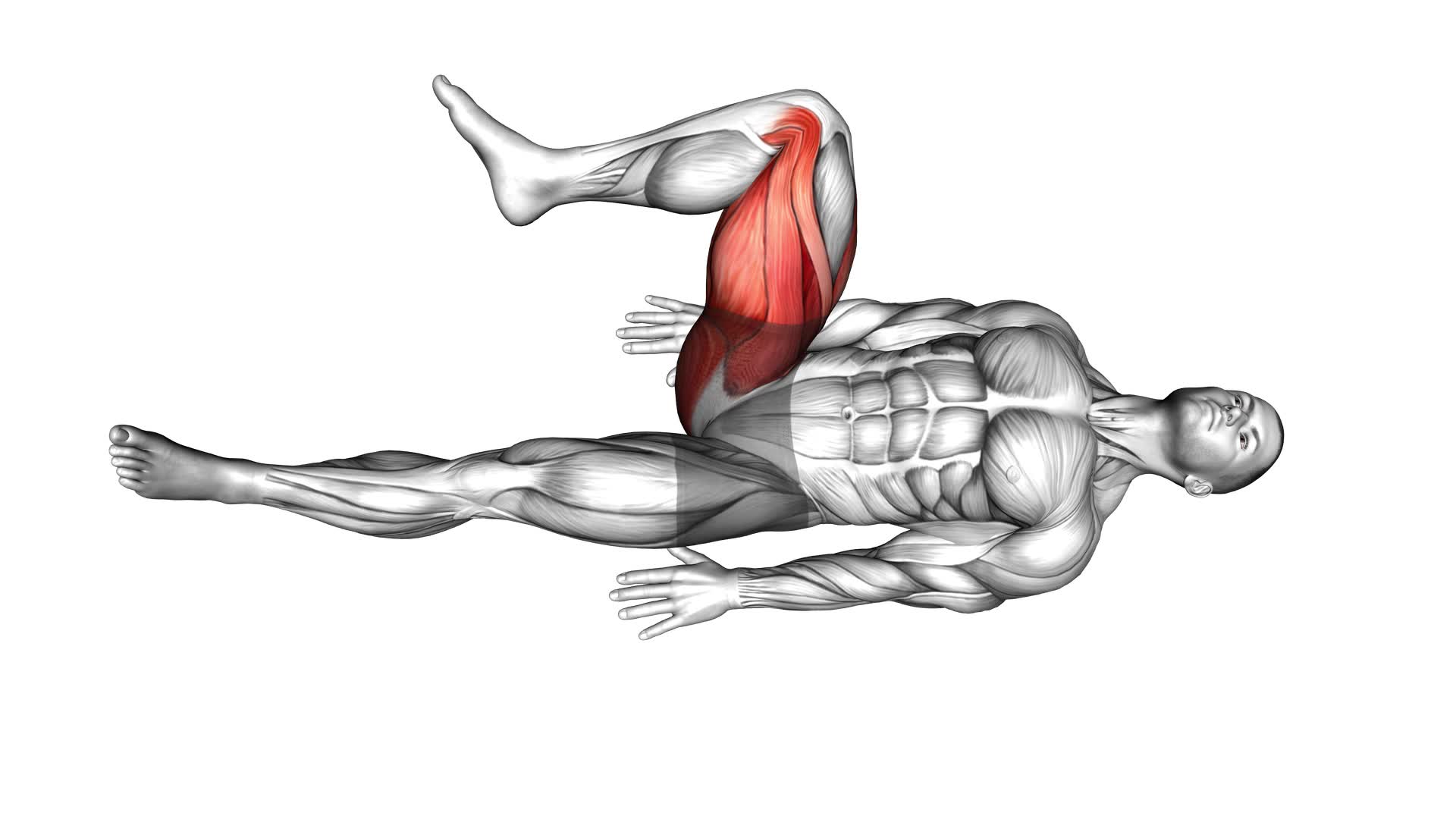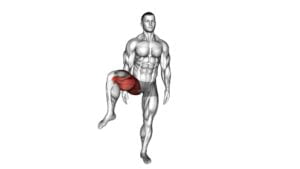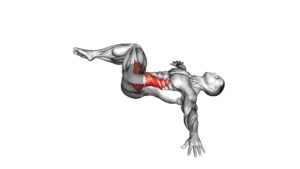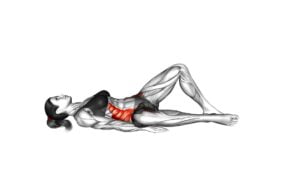Lying Bent Knee Figure 8 – Video Exercise Guide & Tips

Looking to strengthen your core and improve flexibility? Check out our video guide for the Lying Bent Knee Figure 8 exercise!
Watch This Exercise Video
This exercise targets your abs, glutes, and hip flexors, helping you build a strong foundation.
With just a mat and a few minutes of your time, you can start reaping the benefits of this effective workout.
Get ready to feel the burn and watch your fitness goals become a reality.
Let's get started!
Key Takeaways
- The lying bent knee figure 8 targets the abs, glutes, and hip flexors.
- It helps build a strong foundation and engages abdominal muscles and strengthens hip flexors.
- The exercise is versatile and suitable for different fitness levels.
- Equipment such as an exercise mat, stability ball, and dumbbells can be used to increase the challenge and engage upper body muscles.
Benefits of the Lying Bent Knee Figure 8
You will experience numerous benefits from performing the Lying Bent Knee Figure 8 exercise. One of the most important aspects of this exercise is maintaining proper form. By doing so, you can ensure that you're targeting the correct muscles and reducing the risk of injury. To maintain proper form, lie on your back with your knees bent and feet flat on the ground. Keep your core engaged and your lower back pressed into the floor as you perform the figure 8 motion with your legs. This will help to engage the abdominal muscles and strengthen the hip flexors.
Another benefit of the Lying Bent Knee Figure 8 exercise is its versatility. You can modify the exercise to suit different fitness levels. If you're a beginner, you can start by performing the exercise with smaller movements and gradually increase the range of motion as you become more comfortable. For those who are more advanced, you can add resistance by using ankle weights or a resistance band. This will provide an additional challenge and help to further strengthen the muscles.
Equipment Needed for the Exercise
To perform the Lying Bent Knee Figure 8 exercise, you'll need minimal equipment. Here are the three key items you'll need:
- Exercise Mat: It's essential to have a comfortable and supportive exercise mat. This will provide cushioning for your back and knees, making the exercise more comfortable and reducing the risk of injury.
- Stability Ball: A stability ball, also known as an exercise ball, is used to add an element of instability to the exercise. This forces your core muscles to work harder to maintain balance and stability throughout the movement.
- Dumbbells: While not necessary, adding dumbbells to the exercise can increase the challenge and intensity. You can hold them in your hands while performing the figure 8 motion to engage your upper body muscles, such as your biceps and shoulders.
These items are easily accessible and can be found at most fitness stores or online. If you don't have access to a stability ball, you can modify the exercise by performing it on a stable surface, such as a mat or carpet. Similarly, if you don't have dumbbells, you can use water bottles or any other household objects with a comfortable weight. Remember to choose weights that are appropriate for your fitness level and abilities.
Step-By-Step Guide to Performing the Lying Bent Knee Figure 8
To perform the Lying Bent Knee Figure 8 exercise, start by lying on your back on an exercise mat with a stability ball and dumbbells nearby. Bend your knees and place your feet flat on the mat, hip-width apart. Rest your arms by your sides, palms facing down. Engage your core and glutes to lift your hips off the mat, creating a straight line from your shoulders to your knees.
Now, lift your right foot off the mat, keeping your knee bent at a 90-degree angle. Hold a dumbbell in your right hand, extending your arm straight up towards the ceiling. With control, lower your right foot towards the ground, crossing it over to the left side of your body in a sweeping motion. As you bring your foot back up to the starting position, trace the number 8 shape in the air with your foot.
Repeat the movement with your left foot and arm. Alternate between sides for the desired number of repetitions.
There are variations of the figure 8 exercise that you can try. For example, you can perform the exercise with both feet on the mat and use a stability ball between your knees for added resistance. This modification targets your inner thighs and core muscles.
Now that you know how to perform the Lying Bent Knee Figure 8, let's discuss common mistakes to avoid during the exercise.
Common Mistakes to Avoid During the Exercise
One common mistake to avoid during the Lying Bent Knee Figure 8 exercise is improper foot positioning. It's important to ensure that your feet are properly aligned and stable throughout the movement.
Here are three common mistakes to avoid in order to maintain proper form:
- Placing your feet too close together: Having your feet too close together can make it difficult to maintain balance and stability during the exercise. Make sure to position your feet hip-width apart to provide a solid base of support.
- Allowing your feet to turn in or out: When performing the Lying Bent Knee Figure 8, it's crucial to keep your feet in a neutral position. Avoid letting your feet rotate inward or outward, as this can put strain on the knees and compromise the effectiveness of the exercise.
- Lifting your feet off the ground: Throughout the movement, keep your feet flat on the ground. Lifting your feet off the ground can disrupt the flow of the exercise and reduce its effectiveness. Focus on keeping your feet grounded and engaged throughout the entire range of motion.
Tips for Maximizing the Effectiveness of the Lying Bent Knee Figure 8
To maximize the effectiveness of the Lying Bent Knee Figure 8 exercise, focus on maintaining proper form and engaging your core muscles throughout the movement. By following these tips, you can ensure that you're maximizing your results and getting the most out of this exercise.
Firstly, it's important to maintain proper form throughout the entire exercise. Make sure that your back is flat against the ground and your knees are bent at a 90-degree angle. Keep your core engaged and your abdominal muscles tight as you perform the figure 8 movement with your legs. This will help to target your core muscles more effectively and prevent any unnecessary strain on your lower back.
Additionally, you can vary the intensity of the exercise by adjusting the speed and range of motion. To increase the challenge, you can slow down the movement and focus on controlling each repetition. Alternatively, you can increase the range of motion by extending your legs further away from your body during the figure 8 movement.
If you're looking for modifications, you can try performing the exercise with your legs straight instead of bent. This variation will engage your lower abdominal muscles more intensely. You can also use ankle weights or resistance bands to add resistance and further challenge your muscles.
Frequently Asked Questions
How Many Sets and Repetitions Should I Do for the Lying Bent Knee Figure 8 Exercise?
For the lying bent knee figure 8 exercise, it's recommended to do 3 sets of 10 repetitions. This will help target your core and hip muscles effectively.
To maintain proper form and technique, lie on your back with bent knees, feet flat on the ground. Lift your hips off the floor and move them in a figure 8 motion. Keep your core engaged and avoid arching your back.
Remember to breathe steadily throughout the exercise.
Can I Do the Lying Bent Knee Figure 8 Exercise if I Have a Lower Back Injury?
If you have a lower back injury, it's important to modify the lying bent knee figure 8 exercise to avoid aggravating your condition. This exercise primarily targets your core muscles and can be beneficial for building core strength.
However, with a lower back injury, you should consult with a healthcare professional or a fitness trainer to determine the appropriate modifications that will allow you to safely engage in the exercise without putting excessive strain on your lower back.
What Muscles Does the Lying Bent Knee Figure 8 Primarily Target?
The lying bent knee figure 8 primarily targets the hip muscles, specifically the hip flexors, adductors, and abductors. These muscles work together to improve hip mobility and strengthen the surrounding muscles.
The exercise also engages the core and glutes to provide stability and support during the movement.
For advanced trainees, variations of the lying bent knee figure 8 can be performed using resistance bands or weights to increase the intensity and challenge the muscles further.
Is It Necessary to Use a Weight or Resistance Band for This Exercise?
Using weights or resistance bands for the lying bent knee figure 8 exercise and variations can be beneficial. Adding weight or resistance helps to increase the intensity and challenge your muscles even more. It can help to target and strengthen your glutes, hamstrings, and core muscles.
The added resistance also helps to improve stability and balance. So, if you want to take your workout to the next level, consider incorporating weights or resistance bands into your lying bent knee figure 8 routine.
Can I Modify the Lying Bent Knee Figure 8 Exercise to Make It Easier or More Challenging?
To modify the lying bent knee figure 8 exercise and make it easier, you can decrease the range of motion or slow down the movement.
For a more challenging variation, you can add a weight or resistance band to increase the resistance.
These modifications and progressions allow you to tailor the exercise to your fitness level and gradually improve your strength and stability.
Conclusion
In conclusion, the lying bent knee figure 8 is a beneficial exercise that targets the core muscles and improves stability. It requires minimal equipment and can be easily performed at home.
By following the step-by-step guide and avoiding common mistakes, you can maximize the effectiveness of this exercise.
Incorporating the lying bent knee figure 8 into your workout routine will help strengthen your core and enhance your overall fitness level.

Author
Years ago, the spark of my life’s passion ignited in my mind the moment I stepped into the local gym for the first time. The inaugural bead of perspiration, the initial endeavor, the very first surge of endorphins, and a sense of pride that washed over me post-workout marked the beginning of my deep-seated interest in strength sports, fitness, and sports nutrition. This very curiosity blossomed rapidly into a profound fascination, propelling me to earn a Master’s degree in Physical Education from the Academy of Physical Education in Krakow, followed by a Sports Manager diploma from the Jagiellonian University. My journey of growth led me to gain more specialized qualifications, such as being a certified personal trainer with a focus on sports dietetics, a lifeguard, and an instructor for wellness and corrective gymnastics. Theoretical knowledge paired seamlessly with practical experience, reinforcing my belief that the transformation of individuals under my guidance was also a reflection of my personal growth. This belief holds true even today. Each day, I strive to push the boundaries and explore new realms. These realms gently elevate me to greater heights. The unique combination of passion for my field and the continuous quest for growth fuels my drive to break new ground.







